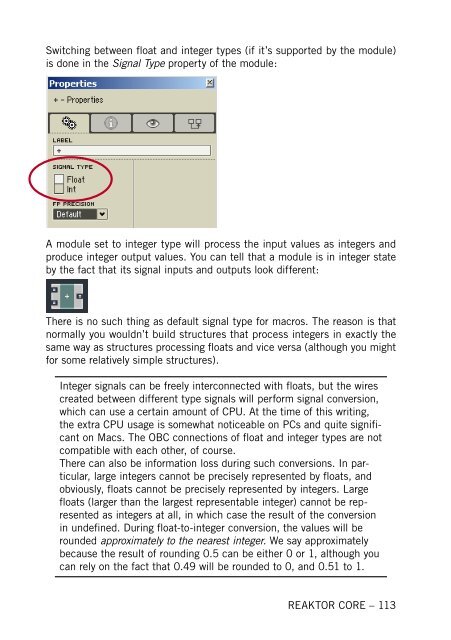1. First steps in Reaktor Core - Native Instruments
1. First steps in Reaktor Core - Native Instruments
1. First steps in Reaktor Core - Native Instruments
You also want an ePaper? Increase the reach of your titles
YUMPU automatically turns print PDFs into web optimized ePapers that Google loves.
Switch<strong>in</strong>g between float and <strong>in</strong>teger types (if it’s supported by the module)<br />
is done <strong>in</strong> the Signal Type property of the module:<br />
A module set to <strong>in</strong>teger type will process the <strong>in</strong>put values as <strong>in</strong>tegers and<br />
produce <strong>in</strong>teger output values. You can tell that a module is <strong>in</strong> <strong>in</strong>teger state<br />
by the fact that its signal <strong>in</strong>puts and outputs look different:<br />
There is no such th<strong>in</strong>g as default signal type for macros. The reason is that<br />
normally you wouldn’t build structures that process <strong>in</strong>tegers <strong>in</strong> exactly the<br />
same way as structures process<strong>in</strong>g floats and vice versa (although you might<br />
for some relatively simple structures).<br />
Integer signals can be freely <strong>in</strong>terconnected with floats, but the wires<br />
created between different type signals will perform signal conversion,<br />
which can use a certa<strong>in</strong> amount of CPU. At the time of this writ<strong>in</strong>g,<br />
the extra CPU usage is somewhat noticeable on PCs and quite significant<br />
on Macs. The OBC connections of float and <strong>in</strong>teger types are not<br />
compatible with each other, of course.<br />
There can also be <strong>in</strong>formation loss dur<strong>in</strong>g such conversions. In particular,<br />
large <strong>in</strong>tegers cannot be precisely represented by floats, and<br />
obviously, floats cannot be precisely represented by <strong>in</strong>tegers. Large<br />
floats (larger than the largest representable <strong>in</strong>teger) cannot be represented<br />
as <strong>in</strong>tegers at all, <strong>in</strong> which case the result of the conversion<br />
<strong>in</strong> undef<strong>in</strong>ed. Dur<strong>in</strong>g float-to-<strong>in</strong>teger conversion, the values will be<br />
rounded approximately to the nearest <strong>in</strong>teger. We say approximately<br />
because the result of round<strong>in</strong>g 0.5 can be either 0 or 1, although you<br />
can rely on the fact that 0.49 will be rounded to 0, and 0.51 to <strong>1.</strong><br />
REAKTOR CORE – 113










